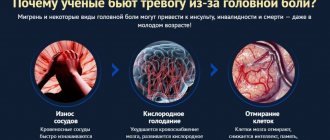Causes of headache and fever
Symptoms such as headache and fever are common symptoms of a wide range of disorders. At home, it is difficult to understand what caused the deterioration in health, so it is important to undergo a full diagnosis. These may be infectious diseases, in which it is recommended to limit contract with others, as well as chronic non-contagious internal diseases in the initial stages.
Viral diseases
Fever and headache are signs of colds, which often appear during the cold season. The viral infection multiplies on the mucous membrane of the upper respiratory tract. Flu, sore throat, ARVI are often diagnosed in adults and children. The severity of these diseases depends on the patient's age, treatment regimen and other factors. It is important to understand that before the first signs appear, the patient already becomes a carrier of infection and poses a danger to others. On average, this period lasts from 3 to 7–10 days.
Tests for infectious viral diseases are carried out if the patient develops characteristic symptoms:
- fever, temperature, headache;
- cough, difficulty breathing, possible sputum production;
- nasal congestion;
- sore throat, inflammation of the mucous membrane of the nasopharynx;
- general weakness, deterioration of health.
One of the stages of diagnosis is fluorography of the lungs. If in the initial stages a viral infection affects only the upper respiratory tract, then it can further spread to the lower sections. This goes away if the patient is not given bed rest in time and a course of treatment is not prescribed. The body's immune defense is not enough to fight infection during periods of seasonal immunodeficiency, in the presence of any chronic diseases in the anamnesis. To quickly regain strength and cope with the virus, rest and plenty of fluids are prescribed, a course of vitamins and antiviral drugs is prescribed, and antibiotics are included if necessary.
Inflammation of the paranasal sinuses
Sinusitis is inflammation of the sinuses. Normally, they are sterile cavities formed by the bones of the skull, inside which there is air. However, when a bacterial infection occurs, purulent inflammation develops, which is accompanied by a severe headache and fever. The disease can be triggered by viral diseases of the respiratory tract, polyps in the nasal passages, swimming in contaminated water, and is also a complication of otitis media and ARVI.
Headache at a temperature of 38 degrees or more may be a sign of the following diseases:
- sinusitis - the most common form of sinusitis, purulent inflammation of the maxillary sinus;
- frontal sinusitis - affects the frontal sinus;
- ethmoiditis - a purulent process in the ethmoid labyrinth;
- sphenoiditis - inflammation of the sphenoid sinus.
Treatment of sinusitis and other sinusitis is prescribed individually. In some cases, taking antibiotics, vasoconstrictor drugs and regular nasal rinsing is sufficient. However, sometimes conservative treatment is ineffective, and to remove purulent contents it is necessary to puncture the maxillary sinuses. This is a painful procedure that doctors try to avoid and prescribe only when absolutely necessary.
Meningitis
One of the dangerous diseases that requires urgent hospitalization and treatment in a hospital is meningitis, an inflammation of the membranes of the brain. The process can develop independently or manifest itself as a complication of infectious pathologies. The first symptoms are chronic headache, which is accompanied by fever. The thermometer readings can remain within 37.5 degrees, but in some patients they rise to a critical level.
There are several types of meningitis, depending on its cause, nature of the course and other features:
- bacterial – develops when a meningococcal infection enters the mucous membrane of the respiratory tract and spreads through the body through the blood;
- purulent - secondary inflammation, which manifests itself as a result of the addition of staphylococcus, E. coli and other bacterial pathogens;
- serous - meningitis, which occurs without purulent complications, is often caused by enteroviruses, as well as polio viruses and other types;
- tuberculous - a specific type provoked by Mycobacterium tuberculosis;
- protozoan - the causative agent is the intracellular parasite Toxoplasma, which enters the body with raw meat and offal.
High fever and headache are a reason to urgently consult a doctor. It is important to understand that some types of meningitis develop due to a viral infection. The disease is transmitted to others, so the patient requires hospitalization in a virus hospital. The process is dangerous because as a result of inflammation, brain cells are destroyed and cannot perform their functions. In the chronic course of meningitis, disruption of the functioning of internal organs, developmental delay in children, as well as complete or partial paralysis are possible. Treatment is aimed at relieving inflammation and preventing purulent complications, as well as restoring neural connections.
Toothache
One of the reasons why you get a headache when you have a fever is dental disease. Tooth decay, nerve inflammation, abscesses and other pathologies can cause severe pain. It spreads to the entire surface of the face, temples and the back of the head. The patient is worried about chronic migraines, fever up to 37 degrees or more. The pain intensifies during chewing and often worsens at night. It is important to see a dentist in a timely manner, and it is not recommended to take painkillers before visiting a doctor.
Poisoning
Headaches and fever in adults and children accompany various poisonings. The main reason is the ingestion of toxins that accumulate in the bloodstream and internal organs. They cause disruption of the digestive tract, liver and excretory system, and can also affect nerve tissue. If toxins reach the brain, the condition is dangerous due to neuronal necrosis and disruption of vital functions. Poisoning can be caused by poor-quality food, poisonous gases, salts of heavy metals, pesticides, certain medications, and alcoholic beverages.
Poisoning can be identified by characteristic symptoms:
- general weakness, sharp deterioration in health;
- headaches, dizziness, possible fainting;
- sharp abdominal pain, disruption of the digestive tract;
- with damage to the nervous system - hallucinations.
Food poisoning can be successfully treated at home. The patient is prescribed a starvation diet and plenty of fluids, sorbents and drugs to restore the microflora of the digestive tract. If your health sharply worsens, it is possible to relieve intoxication only in a hospital setting. In this case, drip infusions of electrolyte solutions are prescribed, as well as drugs to remove toxins from the body.
Thermoneurosis
If the temperature rises with a headache, but tests do not show any deviations from the norm, this may be a symptom of thermoneurosis. The patient’s health is deteriorating, and the patient suffers from chronic migraines. The condition is the body's reaction to the following factors:
- irregular daily routine, lack of rest, night work;
- stress, anxiety;
- disorders of the autonomic nervous system.
The main sign of thermoneurosis is a persistent increase in temperature up to 37 degrees and chronic headaches. The examinations do not detect any pathologies, inflammatory processes, viral infections or other disorders that could provoke a deterioration in health. Doctors recommend proper rest and restoration of a normal daily routine, as well as a course of vitamins. In most cases, such changes have a positive effect on health and help against fever and headaches.
Neoplasms
One of the reasons why it is important to undergo a comprehensive examination for chronic headaches and fever to 37–38 degrees is neoplasms. Brain tumors can be benign or malignant and vary in shape, size and growth rate. They are determined using MRI, and treatment tactics are prescribed individually. It is important that at the initial stages, neoplasms can remain asymptomatic, but then they cause necrosis of nerve tissue and disruption of brain function. Their timely detection is the key to effective treatment, since most functions of the nervous system can be preserved in the initial stages.
Other reasons
Fever and headaches in children and adults are symptoms of a number of pathologies and conditions that can go away on their own or require emergency treatment. They may indicate the following violations:
- intestinal infections - at the initial stages they resemble a cold or flu, but then cause acute digestive upset;
- high blood pressure - with chronic hypertension, the temperature can rise to 37 degrees or more;
- nephritis, pyelonephritis – inflammation of the kidneys;
- any chronic inflammatory processes during the period of exacerbation.
Even a healthy person can experience headaches from time to time. However, if it is accompanied by fever, weakness and other symptoms, this indicates the initial stage of the disease. To select an effective treatment, it is necessary to accurately determine the nature of the pathological process and its cause.
Treatment Options
Treatment tactics depend on the cause of the condition. Possible treatment options:
- antidepressants for anxiety disorders;
- antiviral for herpes infection (Vamciclovir, Famciclovir, Acyclovir, etc.);
- drinking plenty of fluids, bed rest and frequent ventilation during acute respiratory infections and acute respiratory viral infections;
- anti-inflammatory drugs for long-term chronic diseases;
- inactivators of toxic substances and symptomatic therapy for chronic poisoning.
The success of therapy depends not only on the doctor, but also on the patient. If a person is not ready for treatment and ignores the recommendations of a specialist, the chances of recovery are minimal. But with the right tactics and compliance with the instructions, relief occurs within a few days.
Read also: How to treat headaches due to a cold?
Dear patients! Remember that only a qualified doctor can make an accurate diagnosis, determine the causes and nature of the disease, and prescribe effective treatment. You can make an appointment with our specialists or call a doctor at home by calling 8-(4822)-33-00-33
Be healthy and happy!
Examination methods
High-quality and timely diagnosis is the main condition for proper treatment. During the initial examination, temperature is measured and medical history is collected, including information about any chronic diseases. However, to understand the full picture, a number of additional examinations are necessary to make a final diagnosis. The doctor may prescribe the following methods:
- MRI of the head is a comprehensive, informative way to determine tumors, areas of ischemia and other pathologies of the brain;
- CT is a modern method of examination, which also allows you to obtain a complete three-dimensional picture of the brain;
- Dopplerography of the vessels of the head and neck is an important diagnostic stage, thanks to which cerebral circulatory disorders are detected;
- blood tests - tests will indicate inflammatory processes, the presence of infection, poisoning and other pathologies.
The Clinical Brain Institute has modern equipment for diagnosing diseases that are accompanied by headaches. This allows you to accurately and quickly determine the cause of deterioration in health and differentiate pathologies that are similar in clinical picture. It is impossible to make an accurate diagnosis at home, as well as as a result of a simple examination of the patient.
Diagnostics
The examination plan always includes a general blood and urine test. Based on their results, it is possible to determine the presence of an infection of viral and bacterial origin, as well as inflammation in the genitourinary system. A biochemical blood test, including determination of C-reactive protein and liver enzymes, is also indicative.
In some cases, an analysis for tumor markers is indicated. Only a doctor can determine the need for it based on complaints, anamnesis, examination and other studies. Independent assignment of this analysis is impossible due to the large number of indicators and its lack of information in some cases.
Treatment of headache and fever
Treatment tactics for diseases that cause headaches and high fever will differ. It is selected as a result of a complete examination, taking into account many factors. The doctor takes into account the cause of poor health, the stage and form of the disease, as well as the patient’s age and the presence of chronic pathologies in his medical history. There are several methods and stages of treating headaches and fever.
- Drug treatment is prescribed for any pathology. The course may include anti-inflammatory and painkillers, antibiotics, and vasoconstrictors. Symptomatic treatment of colds is also carried out, which includes rinsing the nose. For diseases that affect the brain, therapy is carried out in a hospital and includes drugs to improve cerebral circulation.
- Surgical treatment is prescribed only if conservative methods are insufficiently effective. Surgery may be required to remove tumors that are disrupting brain function and tend to grow rapidly. Surgical techniques are also effective for sinusitis, dental problems, and polyps in the nasal passages.
- Additional techniques are selected separately for various diseases. Thus, for thermoneurosis, a course of physiotherapy and massage, the use of muscle relaxants and mild sedatives are recommended. It is possible to lower the temperature at home, but only if it rises to critical levels (38 degrees or more).
At the Clinical Brain Institute you can get effective recommendations that will help you get rid of headaches, relieve fever and restore a normal lifestyle. Most patients are treated at home, taking prescribed medications. At the end of the course, you must undergo a re-examination to ensure complete recovery or continue treatment. It is impossible to choose the optimal regimen on your own - symptomatic remedies will mask the manifestation of diseases, but will not eliminate their cause.
What else could be causing fever and body aches?
The feeling of body aches and fever can accompany not only the body’s natural fight against infections, but also diseases of a non-infectious nature.
Fever and pain in muscles and joints can be a manifestation of:
- rheumatic diseases affecting the joints, heart, lungs and kidneys;
- autoimmune pathology: rheumatoid arthritis, systemic lupus erythematosus, systemic scleroderma and dermatomyositis;
- tuberculosis of various localizations;
- allergic reactions, in particular allergies to medications: penicillin antibiotics, vitamins, antihistamines, etc.
- oncological diseases: malignant blood diseases, intestinal, liver, pancreas, lung and stomach tumors10.
Only a specialist can evaluate all the symptoms of the disease together, make the correct diagnosis and, if necessary, prescribe treatment. Therefore, if the temperature rises and the body aches, you should immediately consult a doctor.
Up to contents
The information in this article is for reference only and does not replace professional advice from a doctor. To make a diagnosis and prescribe treatment, consult a qualified specialist.
Literature
- Ketova G. G., Menshikova S. V., Popilov M. A. Intoxication. Facets of pathogenesis: old and new. Solution option // Chief physician. — 2021. — No. 2 (54). — P. 44-47.
- Belozerov E. S., Belyaeva T. V., Zmushko E. I., Shuvalova E. P. Infectious diseases. Textbook for medical universities / St. Petersburg: SpetsLit, 2021. - 1320 p. — ISBN: 978-5-299-00611-7.
- Zharkova N. E. Symptomatic treatment of ARVI: the future lies with combination drugs // Russian Medical Journal. – 2007. – No. 22. — S. 1636-1638.
- Yakimova S.S. Symptomatic therapy of ARVI - search for an optimal solution // Medical advice. - No. 1. - 2012. - P.24-27.
- Zhuravleva M.V., Lazareva N.B., Panteleeva L.R. ARVI: rational pharmacotherapy from the perspective of clinical pharmacology // Medical Council. - No. 04. - 2021. - P. 68-72.
- Clark D., Renner B. Caffeine accelerates absorption and enhances the analgesic effect of acetaminophen // Journal of Clinical Pharmacology. — 04/18/2007.
- Instructions for use of RINZA® tablets: , .
- Instructions for use of RINZASIP® with vitamin C: , .
- Instructions for use of RINZASIP® for children: , .
- Vechersky G. A., Goncharik I. I., Matveykov G. P. Handbook of differential diagnosis of internal diseases / Ed. Belarus - 1990. - P. 85-132.
Up to contents
Prevention methods
At home, you can prevent diseases that cause high fever and acute headache. If you follow doctors' recommendations, you can strengthen the immune system, increase the body's resistance to viral diseases, and also identify chronic diseases of internal organs in the early stages. To do this, it is enough to fulfill a few simple conditions:
- avoid hypothermia of the head, especially during sudden temperature changes;
- ensure proper rest and normal daily routine;
- get enough vitamins from food or in medications;
- Lead an active lifestyle and pay attention to physical activity.
The Clinical Institute of the Brain has all the conditions for a full diagnosis and successful treatment of diseases that are accompanied by headaches and fever. High-quality modern equipment, highly qualified specialists and many years of experience, the opportunity to undergo treatment in a hospital setting are the main advantages of the center. Doctors recommend not only contacting the patient at the first symptoms, but also undergoing regular examinations to identify hidden pathologies in the initial stages.
Clinical Brain Institute Rating: 5/5 — 1 votes
Share article on social networks
Why do your eyes hurt when you have a cold?
When you have a cold, pain in the eyes is often caused by severe nasal congestion. In this case, there is redness of the conjunctiva, wings and sinuses, which visibly swell, and profuse lacrimation. There is a constant severe pain in the eyes, it becomes difficult to blink.
The first signs of ARVI are inflammation of the conjunctiva and pain in the eyes. Sinusitis also causes a severe headache, which gets worse when bending over. If ARVI is also accompanied by fever, it also provokes pain, lacrimation, severe burning, and the eyes react to bright light.
At a temperature
When the body temperature increases from 39 degrees and above, the eyes hurt quite noticeably. In this situation, it is important to reduce the temperature as soon as possible. To do this, you need to take various antipyretic drugs, which include substances such as aspirin, paracetamol, ibuprofen, and drink more warm liquids.
Good results for colds with an increase in body temperature above 38 degrees are shown by the drug "Rinza", which has a complex effect: it removes nasal congestion and reduces temperature.








